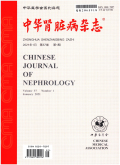抗肾小球基底膜病合并IgA肾病2例及文献复习
Two cases of anti-glomerular basement membrane disease with IgA nephropathy and literature review
摘要目的 报道2例抗肾小球基底膜(glomerular basement membrane,GBM)病合并IgA肾病(IgA nephropathy,IgAN)病例的临床表现和诊疗经过,并系统复习相关文献,总结此类病例的临床病理表现及预后,为该病的诊治提供临床资料.方法 该研究为病例系列分析.收集广西医科大学第一附属医院诊治的2例抗GBM病合并IgAN病例的临床资料.同时检索了PubMed、CNKI数据库自建库至2024年6月30日有关抗GBM病合并IgAN病例报道的相关文献,提取相关临床数据进行分析总结.根据文献报道病例的临床结局将患者分为终末期肾病(end-stage renal disease,ESRD)组和非ESRD组,比较两组患者年龄、性别、血红蛋白、诊断时血肌酐、少尿和/或无尿比例、尿蛋白定性等级、肾脏新月体比例的差异.结果 2例患者均为年轻女性,肾组织病理检查提示新月体性肾小球肾炎,表现为IgG沿GBM呈线性沉积,系膜区有以IgA为主的免疫复合物沉积.例1患者初诊时肾功能损伤并不严重,经血浆置换、糖皮质激素及环磷酰胺治疗后肾功能恢复,长期随访病情稳定.例2患者初诊时肾功能明显下降,经上述药物治疗后肾功能一度好转,后因感染诱发病情加重,肾衰竭持续进展至ESRD,接受维持性血液透析治疗.共检索到26篇共40例抗GBM病合并IgAN的相关文献,分析和总结包括本中心的2例在内共42例抗GBM病合并IgAN病例临床病理资料,年龄(41.3±17.5)岁,男性占比45.2%,39 例(92.9%)来自亚洲,血红蛋白(94.4±15.1)g/L,血肌酐 450.8(284.4,755.8)μmol/L,35例(83.3%)患者新月体比例>50%,37例(88.1%)患者使用过甲泼尼龙冲击及细胞毒药物等免疫抑制治疗,34例(81.0%)患者接受过血浆置换,23例(54.8%)患者肾功能恢复良好,17例(40.5%)患者进展至ESRD.与非ESRD组相比,ESRD组患者初诊血肌酐水平较高(t=-3.70,P<0.01)、少尿和/或无尿比例较高(x2=4.54,P=0.03),两组在年龄、性别、血红蛋白、尿蛋白量和新月体比例等项目上的差异无统计学意义(P>0.05).结论 抗GBM病合并IgAN患者的病程较单纯抗GBM病平缓,总体预后较好,治疗过程中应积极预防感染.
更多相关知识
abstractsObjective To report two cases of anti-glomerular basement membrane(GBM)disease with IgA nephropathy(IgAN),and summarize the clinical characteristics of these patients through systematic literature review,for providing clinical data for the diagnosis and treatment of this disease.Methods It was a case-series analysis.Clinical data of two cases with anti-GBM disease and IgAN diagnosed in the First Affiliated Hospital of Guangxi Medical University were collected.The course of their diagnosis and treatment was described.Besides,the relevant literature of anti-GBM disease with IgAN cases reported in PubMed and CNKI databases from the establishment of the database to June 30,2024 were retrived,and the relevant clinical data were extracted for analysis and summary.Patients were divided into end-stage renal disease(ESRD)group and non-ESRD group according to renal outcome,and the differences in age,gender,hemoglobin,creatinine at diagnosis,proportion of hypuria/anuria,qualitative grade of urinary protein,and proportion of renal crescent were compared between the two groups.Results Two patients were both young women.The pathology of renal tissue suggested crescentic glomerulonephritis.The pathological manifestations were linear deposition of IgG along GBM and deposition of immune complex dominated by IgA in mesangial region.At the initial diagnosis,the renal function damage of the case one was not severe.After plasma exchange,glucocorticoid and cyclophosphamide treatment,the renal function recovered.The kidney function of the case two was obviously impaired at the initial diagnosis,and was improved after the above treatment,but aggravated due to infection,and continued to progress into ESRD.Twenty-six literates involving 40 cases of anti-GBM disease with IgAN were retrieved.A total of 42 cases of anti-GBM disease with IgAN,including 2 cases in this report,were analyzed and summarized.The age was(41.3±17.5)years old,45.2%were male,39 cases(92.9%)were from Asia.The hemoglobin was(94.4±15.1)g/L,the serum creatinine was 450.8(284.4,755.8)μmol/L,83.3%(35/42)patients had crescent ratio greater than 50%and 37 patients(88.1%)patients were treated with intravenous methylprednisolone and cytotoxic immunosuppressive drugs.Plasma exchange was performed in 34 patients(81.0%)patients,23 patients(54.8%)had renal function recovered and 17 patients(40.5%)entered ESRD.Compared with the non-ESRD group,the serum creatinine in the ESRD group was higher at initial diagnosis(P<0.01),and the proportion of hypuria/anuria was higher(P=0.03).There were no statistically significant differences in age,sex,hemoglobin,urinary protein and crescent proportion between the two groups(all P>0.05).Conclusions Compared with anti-GBM disease,anti-GBM with IgAN has a smoother course and a better prognosis.Infection should be actively prevented during treatment.
More相关知识
- 浏览2
- 被引0
- 下载0


相似文献
- 中文期刊
- 外文期刊
- 学位论文
- 会议论文



 换一批
换一批 换一批
换一批



